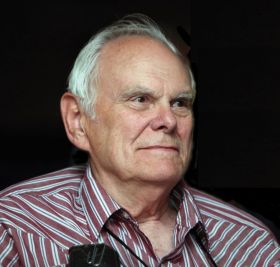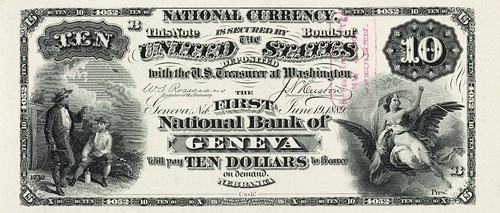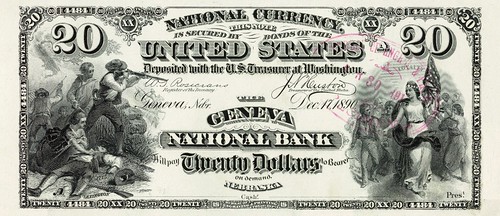
PREV ARTICLE
NEXT ARTICLE
FULL ISSUE
PREV FULL ISSUE
GEROME WALTON (1934-2021)Peter Huntoon submitted this remembrance of paper money collector Gerome Walton; Matt Hansen provided the photo. Thanks! -Editor
Gerome Walton (1934-2021)
Preeminent Nebraska National Collector and Authority by Peter Huntoon
Walton devoted his free time to amassing the most comprehensive collection of Nebraska national bank notes ever assembled. His publication in 1978 of History of Nebraska Banking and Paper Money was a pioneering release of an encyclopedic book on the national bank note issues from a particular state. The book was 647-pages. He tirelessly researched obsolete Nebraska note-issuing banks as well as Nebraska national banks, with a focus on the personalities that ran those banks and signed the notes. His work fitted those stories into the large tapestry of the growth of not only Nebraska but also the nation’s banking enterprise. Gerome was born into a modest home in Geneva, Nebraska, a small rural town in southeastern Nebraska some 60 miles west-southwest of the capital Lincoln. His father was a barber and mother worked at a diner there. He had two brothers. He graduated from Geneva High School in 1952. Although he had to leave to find opportunity, he had deep roots in Geneva and a fierce loyalty to Nebraska that lasted his lifetime. Gerome was a big fellow, about 6’ 3 with a sharp technical mind. He joined the Air Force in August 1953 and served a four-year stint. Upon his discharge, he earned an associates degree in electronics from Central Tech Institute in Kansas City in 1959. By 1961 he was working as an electronics technician for Philco, a firm that pioneered in radios, household appliances, early computers, TV, etc. In short order after he arrived, Philco was purchased by Ford Motor Company and became the Philco-Ford division. Gerome’s job required frequent moves but his attachment to Nebraska never wavered. He married Ruth McConnell in 1960 and they parented three children, Valerie (1961), Vincent (1963) and Vicky (1970). Ruth was very supportive of Gerome’s numismatic pursuits. She died in January 2011. In 1962, the Philco 2000 Model 212 computer was selected for use in the North American Aerospace Defense Command's (NORAD) famous Cheyenne Mountain Complex. NORAD is a joint U. S.-Canadian defense organization charged primarily with providing aerospace warnings of threats such as the launch of nuclear missiles by enemies. It operates satellites, ground-based radar, airborne radar and fighters to detect, intercept and, if necessary, engage any threats to Canada and the United States. NORAD operates a nerve center from a tunnel complex in Cheyenne Mountain, a facility designed to withstand nuclear detonations.
Gerome was transferred to Cheyenne Mountain by Philco-Ford in 1972 to maintain vital electronic equipment there under a civilian contract. Philco-Ford became Ford Aerospace Communications, which eventually was assimilated into defense contractor Lockheed Martin. He retired after spending 32 years as he said Being a resident of Colorado Springs, Gerome naturally volunteered at the American Numismatic, even serving a stint as treasurer. Gerome’s book on Nebraska notes was pivotal. It accomplished two firsts for the hobby. He was the first person to crack into the national bank note proofs in the National Numismatic Collection in the Smithsonian Institution. The transfer of the proofs began from the Bureau of Engraving and Printing in 1966 and was completed in 1980. Gerome got wind that the nationals had already arrived as he was gearing up to work on his book. Vladimir Clain-Stefanelli was the curator at the time but was very tightlipped about the proofs because they were in a poor state of organization and poorly housed, and besides he had little interest in them. After a couple of years of very persistent inquiries, Clain-Stefanelli finally relented realizing this fellow was a serious researcher. He assigned his assistant Butch Vosloh to locate and dig out the proofs for otherwise unreported banks that Gerome wanted to use as illustrations and arranged for them to be photographed. When they appeared in the book, our community indeed saw that this was a treasure trove that had to be mined. Clain-Stefanelli died and Vosloh left for a curatorial job at the BEP. Jim Hughes took over as collections manager and suddenly the doors were thrown open. Now through the Smithsonian website everyone has access to images of the proofs, one of the greatest resources in numismatics. The other great contribution associated with Gerome's book was his compilation of yearly bank-by-bank president and cashier officer data from the annual reports of the Comptroller of the Currency. In the process, Gerome identified two distinct dates associated with the founding of a national bank, the date of organization and date of charter. He came to realize that the date of organization was the day when the corporate life of a bank began. The date of charter was simply the day the Comptroller authorized the bank to begin business. Until then, virtually no numismatist even knew about the date of organization. Several of us wondered what the significance of the plate dates were that appear on the faces of large size nationals. Gerome soon recognized that the date of charter or date of organization appeared on the first plates made for all banks from 1882 forward, depending on the vintage of the notes. He also recognized that the dates on the successive series issued by a bank were dates of extension of corporate life. It was breakthrough news when these insights hit. Using this information as the key, it didn’t take long for us to determine the significance of all the plate dates that appeared on our notes. A later fundamental contribution that he made came in 2002 when he published an article in Paper Money entitled Impact of Nebraska’s bank deposit guaranty law of 1909-30. This piece developed the story of Nebraska’s bank deposit guarantee law and its impact on national banks in Nebraska. State-run deposit guaranty laws were passed elsewhere in the Plains States, best typified in Oklahoma. They set up insurance fund to protect depositors in state banks in the event the bank failed. There ensued a rush to liquidate national banks and reorganize them under state charters to take advantage of this program. It didn’t take long for the state insurance funds to face bankruptcy and the idea imploded. Many banks that had fled the national system quickly returned, usually with their identical former names. Gerome joined with me and for a time with Mark Hotz to offer a national bank note course through the ANA summer seminar series. We didn’t miss many summers between 2000 and the Covid crash in 2020. The highlight for participants was when Gerome arrived lugging his collection that spilled out and overflowed all the tables in the room as he spun his tales. He indeed set the standard for how to enjoy this stuff and it continued to thrill him to the end. Gerome wrote several articles, most for The Numismatist, chronicling the interesting and ironic tales associated with Nebraska note-issuing banks and bankers. He always was plugging away at another Nebraska story, and did so right up until he died in the saddle. There is unfinished work spread around his living room.
Gerome was a rather laid-back unassuming guy. Underneath that veneer was a tireless methodical person with stereotypical Germanic drive. He was a fellow from rural Nebraska who revealed in the mystique of having his feet planted firmly in a Plains State and culture. He approached life with an optimism, wry sense of humor and an enduring youthful sense of awe that were infectious. He generously pressed his passion on to anyone willing to engage him. His manner of speech was understated. Excitement elicited Although he spent most of his career in Colorado Springs, Gerome’s hometown remained Geneva, Nebraska, where he is to be interred with Ruth. Gerome’s numismatic regret was never finding a note from either of the two national banks that operated in Geneva. They were The First National Bank of Geneva, charter 4052, and The Geneva National Bank, charter 4484. Both were early short-lived banks that issued pocket change in $10 and $20 Series of 1882 brown backs. The First National was chartered in 1889 and liquidated just three and a half years later in 1894. The Geneva National opened in 1891 and was liquidated in 1899 in order to be reorganized as the Geneva State Bank. No notes have been reported from either bank. Wayne Homren, Editor The Numismatic Bibliomania Society is a non-profit organization promoting numismatic literature. See our web site at coinbooks.org. To submit items for publication in The E-Sylum, write to the Editor at this address: whomren@gmail.com To subscribe go to: https://my.binhost.com/lists/listinfo/esylum All Rights Reserved. NBS Home Page Contact the NBS webmaster 
|



